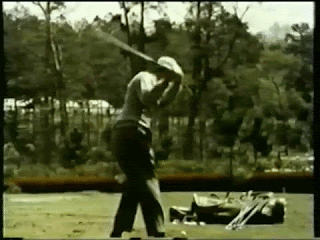As mentioned in the Slap-Hinge Release articles, the key position for our spines to minimize any other movements is lateral side bend. That is why we recommended an exaggerated primary axis tilt so that the rotation of the spine (mainly thoracic, to a lesser degree lumbar and cervical parts) is not so violent. In fact, the best would be to set the spine in the secondary axis tilt position at setup; it is not quite possible because of the nature of the whole motion, but surely the amount of the secondary axis tilt amount will be diminished.
We have created recently very useful notions of WAB (well-anchored bow) and SWAB (stretched well-anchored bow) so that it is easy to have these ideas in mind. Please take a look above at this beautiful sequence of Sam Snead consisting of address position and transition. We would like to draw everyone's attention more to the process of "stretching the bow" than to creating the secondary axis tilt. We underline strongly also the word "well-anchored" as it has a vivid connotation to feet that have to be extremely quiet and stable as well as slightly closed feet line in relation to the target and flared out decently.How to archor it well and stretch well ? We need to be firm on the ground with our feet first. Next we need to exaggerate the primary axis tilt in the pelvic area which is equal to move the lead hip laterally targetwise; if you remember the famous Hogan's bump at transition (above), it is easy to understand this move and perform it well at address. Please also refer to the two articles about the Firm Lead Side and the notion of fixed extension at address.
We simply need to sit onto the lead hip, so to speak which prepares the lead hip for retaining firm position before going to SWAB procedure. The best results were obtained when rotating both flexed hips medially (colloquially it refers to spreading buttocks away) which move is responsible for the stretching part. Important part is that this position helps to retain hips in flexion until they both start to extend and rotate laterally well before entering the impact zone unintentionally. Look how it looks in motion of a great ballstriker from the rear (Mac O'Grady):
Another important aspect in the Senior Swing is the so-called depressed rear shoulder backswing which is related very closely to the exaggerated primary axis tilt. We need to eliminate steepness of the shoulders (reducing up & down movements) from the entire motion as it makes finding long flat spot on a reliable basis very difficult. We always liked how the best ballstrikers were pivoting squarely to their spines but we never stressed that shoulder girdle can behave differently to the spine, e.g. flatter or steeper. We need definitely the first one, tending to be almost parallel to the ground and, to our grand pleasure, we can observe this phenomenon in many swings of past greatest champs and best ballstrikers. Presetting protraction and depression (mentioned earlier in our articles concerning The Arms Situation) surely helps a lot in achieving that. Lastly, having the flat rear shoulder backswing is entirely compatible to the preset rear elbow in flexion that we talked about in the last article.

It is unbelievable how many things still remain unseen and, thus, not used in the golf swing instruction industry. The next part no. 4. of the article series will be even more shocking for many, I believe.


















